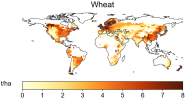Hello @samrabin
I am running the CLM5 model for evaluating the spring wheat and rice crop phenology and yield. I am using the following compset: HIST_DATM%GSWP3v1_CLM50%BGC-CROP_SICE_SOCN_SROF_SGLC_SWAV.
As discussed in earlier thread, i am facing issues while converting GRAINC_TO_FOOD to yield. I have GRAINC_TO_FOOD written daily to the output. I do not have the GRAINC_TO_FOOD_ACCUM_PERHARV variable written to the output.
I am attaching the file that explains the method used to convert GRAINC_TO_FOOD to yield. In the attachment, CLM-D is the simulation with default settings for the spring wheat and rice. CLM-M is the simulation with a modified planting window, Tbase for GDD calculation, GDDmat, and planting temperatures for both spring wheat and rice.
Thanks and regards
I am running the CLM5 model for evaluating the spring wheat and rice crop phenology and yield. I am using the following compset: HIST_DATM%GSWP3v1_CLM50%BGC-CROP_SICE_SOCN_SROF_SGLC_SWAV.
As discussed in earlier thread, i am facing issues while converting GRAINC_TO_FOOD to yield. I have GRAINC_TO_FOOD written daily to the output. I do not have the GRAINC_TO_FOOD_ACCUM_PERHARV variable written to the output.
I am attaching the file that explains the method used to convert GRAINC_TO_FOOD to yield. In the attachment, CLM-D is the simulation with default settings for the spring wheat and rice. CLM-M is the simulation with a modified planting window, Tbase for GDD calculation, GDDmat, and planting temperatures for both spring wheat and rice.
Thanks and regards

